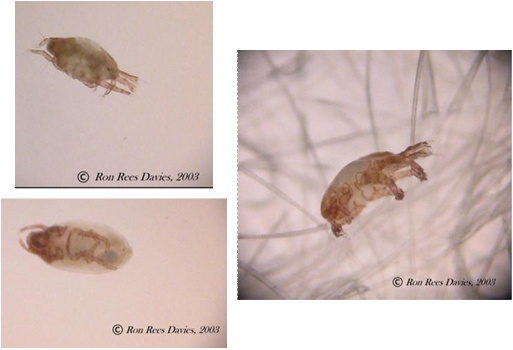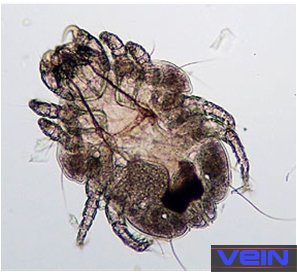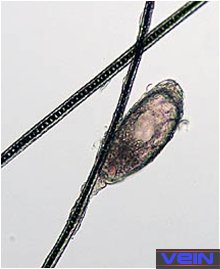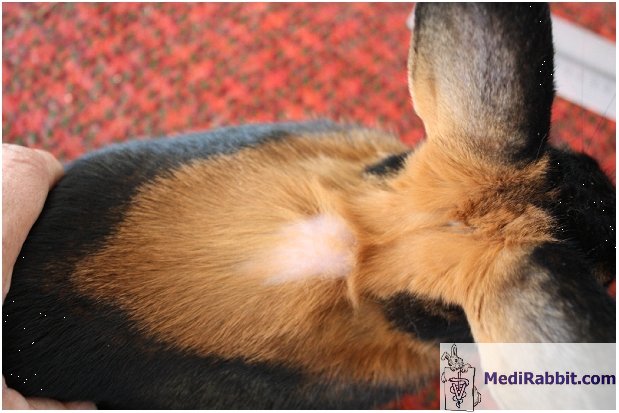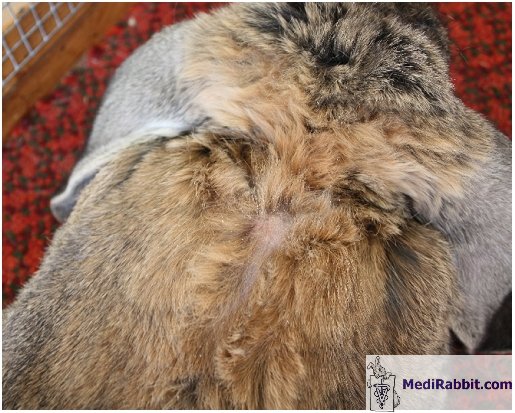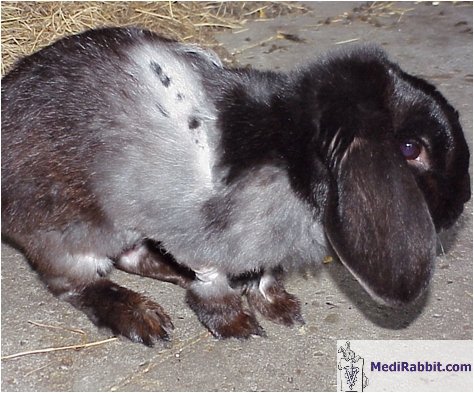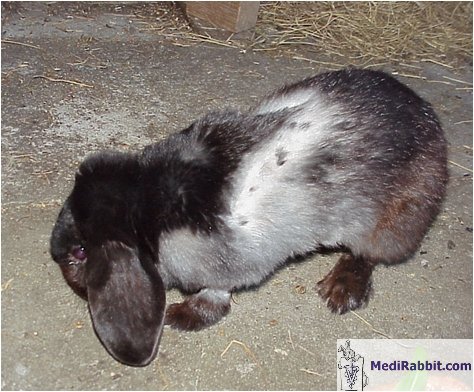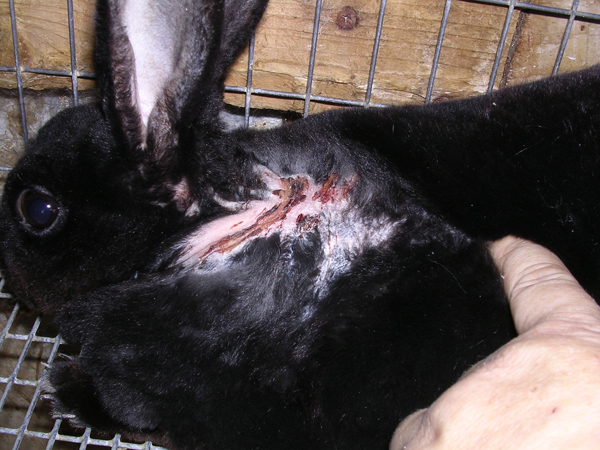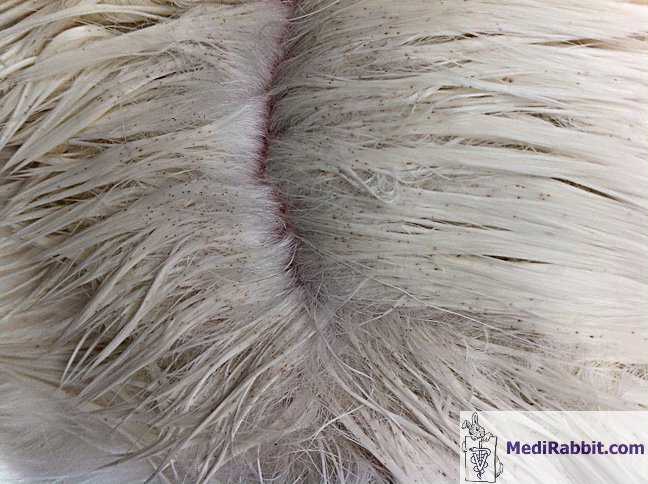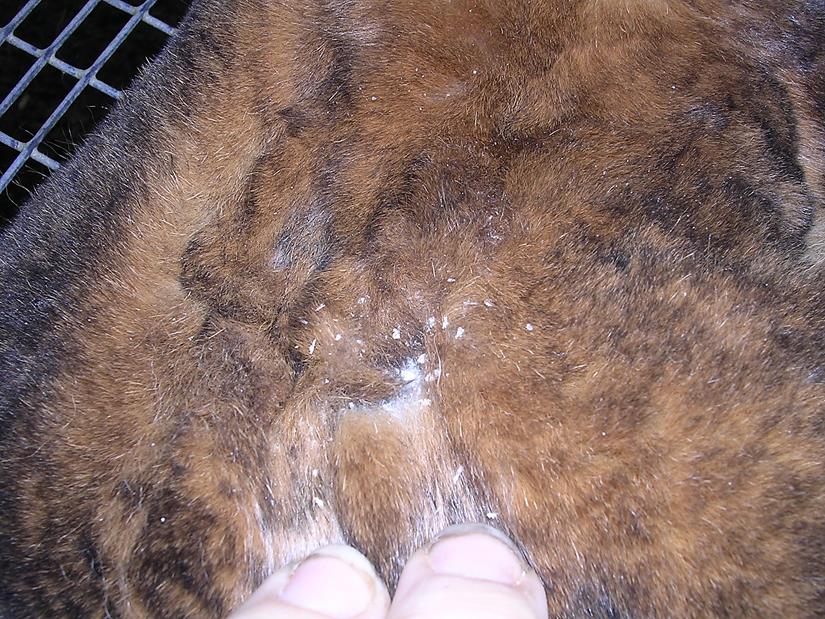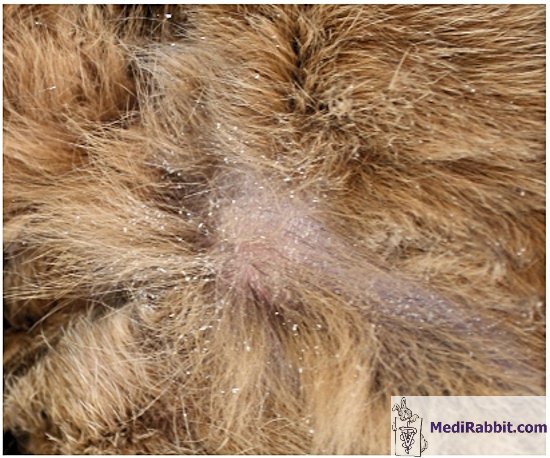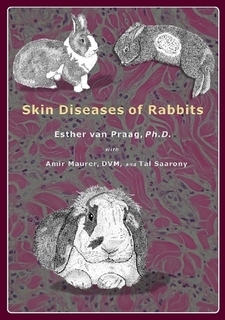Common Fur Mites or Cheyletiellosis
Esther van Praag Ph.D.
|
MediRabbit.com is
funded solely by the generosity of donors. Every
donation, no matter what the size, is appreciated and will aid in the
continuing research of medical care and health of rabbits. Thank you |
Rabbits
can be infested with non-burrowing skin mites Cheyletiella
parasitovorax and Leporacarus
gibbus. These parasites are encountered around the
world and affect mainly rabbits but also cats and dogs.
Cheyletiella parasitovorax parasites live in close
association with the keratin layer of the skin but they do not burrow into
the skin. It is suspected that mites may be present asymptomatically in small
numbers on healthy rabbits. The development from egg to adult mite takes
place on the same rabbit host. The female lay eggs and stick them to the hair
about 3 to 4 mm above the skin. The life cycle takes about 5 weeks under
optimal conditions.
Cheyletiella parasitovorax has a zoonotic potential,
causing a transient itching dermatitis in humans.
Clinical signs
Fur mites appear associated with spring when weather becomes milder, with
a lack of vitamin C due to e.g., stress, or due to an underlying disease,
which suppresses the immune system.
The presence of fur mites is not always easy to
determine. When present, Cheyletiella parasitovorax is most likely to be found on the
dorsum and neck of the rabbit, where it causes dandruff, seborrheic lesions
(lesions from abnormally increased secretion of fatty matter), and a pruritic
(itching) condition. Leporacarus gibbus is found
mainly on the dorsum and abdomen. The presence of fur mites can lead to skin
hypersensitivity reactions.
Irritation and prurit caused by the presence
of mites can lead to excessive scratching and mutilation of the skin.
Diagnosis
Diagnosis can be difficult and
visual examination is not always sufficient to confirm the presence of ear
mites. Detection methods include the tape method, skin scraping (shallow if
fur mites are suspected, deep if burrowing mites are suspected), or the
vacuum aspiration method on a filter paper. Samples from scraping or
aspiration should be spread on a microscope glass, dissolved in KOH, and
examined under a microscope. Great is the chance to see at least one mite or
a larva or eggs. Fur can also be sampled, dissolved in KOH, and examined
under the microscope for the presence of eggs. If no mite is present in the
first sample, other places on the body should be checked. If the presence of
burrowing mites is suspected, but none found after a deep skin scraping, a
biopsy on the area suspected of mite infestation is advisable.
Treatment
Fur mites are eliminated
by ivermectin: 0.2-0.4 mg/kg, PO (oral) or SC (subcutaneous injection), 3
times at intervals of 10-14 days. Ivermectin can also be used topically
(directly on the skin). Dips (Aludex® - Hoechst; Seleen® - Sanofi; LymDyp® -
DVM) can be used to treat the seborrhea (excessive secretion of fat by the
skin) and remove the keratin layer on which the mites feed; they will not
kill the parasite. Although fipronil (Frontline® - Merial)
is effective in eliminating Cheyletiella sp.,
the manufacturer forbids the use of Frontline® on rabbits. Serious
adverse effects (depression, anorexia, seizures, death)
have been observed in rabbits, especially young or small rabbits. Imidacloprid (Advantage® - Bayer) is ineffective against Cheyletiella
sp. mites. Treatment of the environment is important (boric acid
such as Fleabusters®; Vet-Kem Acclaim Plus® - Sanofi; Staykil®
- Novartis; Indorex® - Virbac;
acaricide spray). When treating a carpet, vacuum first in order to
further penetration of the spray or powder. Shampooing and steam cleaning are
not ideal; their residual humidity can increase the mite problem. During
treatment of the environment, rabbits should be kept in another part of the
home to avoid the danger of contact with the products. Acknowledgements
Thanks are due to Ron Davies,
BVSc., CertZooMed., MRCVS (UK), Michel Gruaz (Switzerland), Bruno Feirrera
(Switzerland), Ils Vanderstay
(Belgium), Pamela Alley (USA) and Akira Yamanouchi, (Veterinary Exotic
Information Network, Japan, https://vein.ne.jp/), for the permission to use their
illustrative material. For detailed information on fur mite infestation in
rabbits, see: “Skin Diseases of Rabbits”, by E. van Praag, A. Maurer and
T. Saarony, 408
pages, 2010. Further Readings
Beck W. Farm animals as disease vectors of parasitic epizoonoses and zoophilic dermatophytes and their
importance in dermatology. Hautarzt. 1999;
50(9):621-8. Cerny V, Rosicky B. Mammals as source of ectoparasites
in towns. Folia Parasitol (Praha). 1979; 26(1):93‑5. Isingla LD, Juyal PD, Gupta PP. Therapeutic trial of ivermectin
against Notoedres cati
var. cuniculi infection in rabbits. Parasite. 1996; 3(1):87-9. Kirwan AP, Middleton B, McGarry JW.
Diagnosis and prevalence of Leporacarus gibbus in the fur of domestic rabbits in the UK. Vet
Rec. 1998; 142(1):20-1. Pinter L. Leporacarus gibbus and Spilopsyllus
cuniculi infestation in a pet rabbit. J Small Anim
Pract. 1999; 40(5):220-1. Wagner R, Wendlberger U. Field efficacy of moxidectin
in dogs and rabbits naturally infested with Sarcoptes
spp., Demodex spp. and Psoroptes spp.
mites. Vet Parasitol. 2000; 93(2):149-58. |
e-mail: info@medirabbit.com



